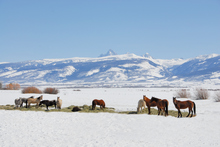According to research, pigeon fever is more prevalent in the fall of the year, but can be seen in the winter months and other times of the year. Initially horses may appear lethargic, reluctant to move and have a fever. But these signs are typically accompanied by deep external abscesses that appear in the muscles of the breast, underside of the abdomen and groin area, the udder or sheath.

Horse disease - A winter occurrence
Pigeon fever is more prevalent in the fall of the year, but can be seen in the winter with horses initally appearing lethargic, reluctant to move and feverish with internal and external abscesses.
Pigeon fever can also manifest as internal abscesses which are very difficult to treat, or as ulcerative lymphangitis, a limb infection. The external abscess form is the most common and the prognosis is generally good. The external abscesses can range from small contained areas of infection to severe massive deep abscesses containing large volumes of tan pus.
The corynebacterium pseudotuberculosis that causes the disease lives in soil and is thought to gain entrance to a horse’s body by a wound, some type of broken skin, or mucous membrane. The bacteria is probably transmitted to a susceptible horse by contact with contaminated soil, an infected horse or an insect transmitting the bacteria from an infected horse.
Because the bacteria is contagious and can easily be transmitted to other horses on the farm timely veterinary care is important.
The infections need to be accurately diagnosed and appropriately treated. Infected horses should be isolated, with proper disposition of any infectious material, followed by complete cleaning/ disinfection of contaminated areas.
Read more about Pigeon Fever
